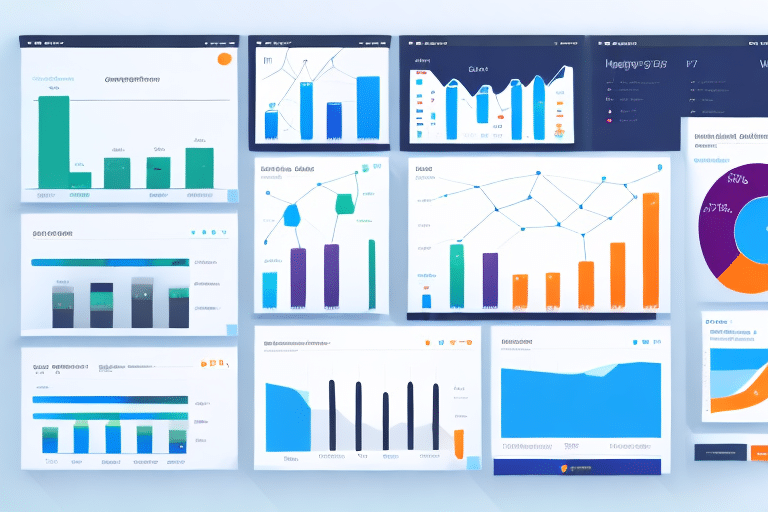How to Create Content for Your Ecommerce Business: A Step-by-Step Guide
Content is king in the digital age, and creating quality content is essential for any ecommerce business looking to succeed online. With fierce competition, standing out and driving traffic to your website can be challenging. That's where a solid content marketing strategy comes into play. In this article, we'll take a step-by-step approach to creating content for your ecommerce business that is engaging, informative, and drives sales.
Why Good Content is Important for Your Ecommerce Business
Good content is the cornerstone of any successful ecommerce business. It not only informs and engages potential customers but also helps establish your brand as an authority in your industry. Effective content marketing can drive traffic to your website, improve your search engine optimization (SEO), and ultimately lead to increased sales.
High-quality, engaging content builds trust with your audience, fostering repeat customers and generating positive word-of-mouth recommendations. According to a HubSpot report, companies that prioritize blogging are 13 times more likely to see positive ROI.
One of the key benefits of good content is differentiation from competitors. Unique and valuable content sets you apart, attracting more customers and establishing your brand's voice and personality. By consistently producing high-quality content, you can build a loyal following and position your business as a trusted source of information and products in your industry.
Identifying Your Target Audience for Effective Content Creation
Identifying your target audience is crucial for creating content that resonates with potential customers. Start by understanding your ideal customer’s demographics, interests, pain points, and motivations for making a purchase. This clarity allows you to tailor your content to their specific needs and interests, increasing engagement and boosting sales.
- Demographics: Age, gender, income level, education, and occupation.
- Interests: Hobbies, preferences, and lifestyle choices.
- Pain Points: Challenges and problems your customers face.
- Motivations: Reasons behind their purchase decisions.
Conducting market research is an effective way to identify your target audience. Analyze data on your current customers, research your competitors, and stay updated with industry trends. Tools like Google Analytics and SEMrush can provide valuable insights into your audience's behavior and preferences.
Additionally, consider the format and platform preferences of your target audience. Different audiences may prefer various types of content, such as videos, blog posts, or social media updates. Understanding where your audience spends their time online and what types of content they engage with most can enhance the effectiveness of your content strategy.
Conducting Keyword Research for Better Visibility
Keywords are the phrases and terms people use when searching online for products or services like yours. Conducting thorough keyword research helps you understand what your potential customers are searching for and improves your visibility in search engine results pages (SERPs).
Use tools like Google Keyword Planner, SEMrush, and Ahrefs Keyword Generator to identify relevant keywords and phrases. Incorporate these keywords naturally into your content to enhance search visibility without compromising readability.
Keyword research is an ongoing process. As search trends and user behaviors evolve, so do the keywords and phrases relevant to your business. Regularly reviewing and updating your keyword strategy ensures you stay ahead of the competition and continue attracting high-quality traffic to your site.
Balance is essential when incorporating keywords. Avoid "keyword stuffing," which can harm your search rankings and deter potential customers. Focus on creating high-quality, informative content that seamlessly integrates relevant keywords.
Crafting Compelling Headlines to Grab Attention
Headlines are the first thing readers see, making them crucial for capturing attention and encouraging clicks. A strong headline can significantly increase click-through rates and engagement with your content.
- Focus on Benefits: Highlight what the reader will gain.
- Evoke Emotion: Use words that trigger an emotional response.
- Convey Urgency: Encourage immediate action with time-sensitive language.
- Keep it Concise: Aim for clarity and brevity.
Test different headline variations to determine what resonates best with your audience. Tools like CoSchedule’s Headline Analyzer can help optimize your headlines for maximum impact.
Ensure that your headlines accurately reflect the content of your article. Misleading or clickbait headlines may attract initial clicks but can damage your credibility and reduce long-term engagement.
Writing Product Descriptions that Convert
Your product descriptions play a pivotal role in driving sales. They must be informative, engaging, and persuasive to convince potential customers to make a purchase.
- Highlight Benefits: Clearly explain how the product solves a problem or improves the customer’s life.
- Use Relevant Keywords: Incorporate terms your target audience uses naturally.
- Unique Features: Showcase what sets your product apart from competitors.
- Social Proof: Include positive reviews or testimonials.
- Clear Structure: Use bullet points and short paragraphs for readability.
Keep descriptions concise and avoid overly technical language that might confuse or intimidate customers. Provide all necessary information, including size, weight, color, and other pertinent details.
End your product descriptions with a strong call-to-action (CTA). Encourage readers to take action, such as making a purchase or contacting your sales team, using action-oriented language and creating a sense of urgency.
Creating Engaging Blog Posts to Drive Traffic
Blog posts are an excellent way to drive traffic to your website and establish your brand as an authority in your industry. Focus on topics that interest your target audience and provide value through informative and engaging content.
- Identify Relevant Topics: Use keyword research to find subjects that your audience is searching for.
- Provide Value: Offer actionable insights, tips, and solutions to your audience’s problems.
- Incorporate Visuals: Use images, infographics, and videos to enhance your content.
- Optimize for SEO: Use relevant keywords naturally and include internal and external links.
- Include a CTA: Encourage readers to engage with your brand, subscribe to your newsletter, or explore your products.
According to Content Marketing Institute, businesses that blog regularly receive 55% more website visitors. Consistent blogging can significantly boost your SEO efforts and drive sustained traffic to your site.
Developing Visual Content to Enhance Your Brand
Visual content, such as images, infographics, and videos, can greatly enhance your brand and make your content more engaging. High-quality visuals not only attract attention but also help communicate complex information more effectively.
- Showcase Products: Use clear, high-resolution images and videos to display your products in action.
- Create Infographics: Simplify complex concepts and data into easy-to-understand visuals.
- Engage on Social Media: Share visually appealing content to increase shares and drive traffic back to your website.
- Optimize for SEO: Use descriptive file names and alt texts to improve search engine visibility.
According to HubSpot, visual content is more than 40 times more likely to get shared on social media than other types of content.
Utilizing Social Media for Amplification and Engagement
Social media platforms are powerful tools for amplifying your content and engaging with your audience. Identify which platforms your target audience frequents and tailor your content accordingly.
- Create Platform-Specific Content: Design content that fits the format and style of each platform, whether it’s Instagram, Facebook, Twitter, or LinkedIn.
- Share Diverse Content: Post blog articles, product images, videos, and behind-the-scenes glimpses of your business.
- Use Hashtags: Increase visibility and reach by using relevant hashtags.
- Encourage Sharing: Prompt followers to share your content and engage with it through likes, comments, and shares.
- Respond Promptly: Engage with comments and messages in a timely manner to build trust and foster a community around your brand.
According to Statista, as of 2023, there are over 4.9 billion social media users worldwide, making it an essential channel for reaching potential customers.
Measuring the Success of Your Content Marketing Strategy
Measuring the success of your content marketing strategy is vital for understanding what works and what doesn’t. Use analytics tools to track key performance indicators (KPIs) and adjust your strategy accordingly.
- Website Traffic: Use Google Analytics to monitor the number of visitors to your site.
- Bounce Rate: Track the percentage of visitors who leave your site after viewing only one page.
- Conversion Rate: Measure the percentage of visitors who take a desired action, such as making a purchase.
- Engagement Rates: Analyze how users interact with your content on social media platforms.
- Campaign Performance: Assess the effectiveness of specific marketing campaigns and initiatives.
Use this data to refine your content marketing strategy, focusing on the tactics that yield the best results and eliminating those that do not.
Tips for Consistently Producing Quality Content
Consistency is key when creating content for your ecommerce business. Develop a content calendar to maintain a regular publishing schedule and ensure a steady flow of fresh content.
- Content Calendar: Plan your content topics, formats, and publication dates in advance to stay organized and consistent.
- Repurpose Content: Transform existing content into new formats, such as turning blog posts into videos or infographics.
- Outsource When Necessary: Consider hiring professional writers or agencies to help maintain a high standard of content quality.
- Focus on Quality Over Quantity: Prioritize creating valuable, informative content that provides real benefits to your audience.
- Stay Updated: Keep abreast of industry trends and incorporate relevant topics into your content strategy.
By maintaining consistency and quality, you can build a loyal audience and enhance your brand’s reputation.
Staying Ahead of the Competition with Innovative Content Ideas
Innovation is essential for staying ahead in the competitive landscape of ecommerce. Continuously brainstorm new and creative ways to engage your audience and differentiate your brand.
- Interactive Content: Incorporate quizzes, polls, and interactive infographics to engage users actively.
- Webinars and Live Streams: Host online events to provide value and interact with your audience in real-time.
- Influencer Partnerships: Collaborate with influencers to reach new audiences and add credibility to your brand.
- Co-Branded Content: Partner with complementary brands to create content that benefits both parties.
- Augmented Reality (AR): Utilize AR to allow customers to visualize products in their environment before purchasing.
By embracing innovative content ideas, you can capture your audience’s attention and keep your content strategy fresh and exciting.
The Dos and Don'ts of Ecommerce Content Creation
Creating effective content for your ecommerce business involves adhering to certain best practices while avoiding common pitfalls.
Dos
- Highlight Product Benefits: Clearly communicate how your product solves a problem or adds value.
- Use High-Quality Visuals: Incorporate clear images and videos to showcase your products effectively.
- Maintain Consistent Tone: Ensure your content reflects your brand’s voice and personality consistently.
- Optimize for SEO: Use relevant keywords and meta descriptions to improve search engine visibility.
- Engage Your Audience: Encourage interaction through comments, shares, and calls-to-action.
Don'ts
- Avoid Overly Salesy Language: Don’t come across as pushy or desperate; focus on providing value instead.
- Don’t Keyword Stuff: Overusing keywords can make content unreadable and harm your SEO.
- Neglect Mobile Optimization: Ensure your content is easily accessible and readable on mobile devices.
- Don’t Ignore Analytics: Failing to track performance metrics can prevent you from understanding what works.
- Avoid Generic Content: Provide unique and specific information to stand out from competitors.
Outsourcing vs In-House Content Creation: Which is Right for You?
Deciding between outsourcing content creation and keeping it in-house is a crucial decision for your ecommerce business. Both approaches have their advantages and challenges.
Outsourcing
- Pros:
- Access to professional writers and diverse expertise.
- Scalability to handle large volumes of content.
- Time-saving, allowing you to focus on core business activities.
- Cons:
- Less control over content quality and brand voice.
- Potentially higher long-term costs.
- Communication challenges and possible delays.
In-House Content Creation
- Pros:
- Greater control over content quality and consistency.
- Deep understanding of your brand and products.
- Immediate communication and collaboration.
- Cons:
- Requires investment in hiring and training skilled staff.
- Limited scalability for large content demands.
- Potential strain on internal resources.
Consider your business’s specific needs, budget, and resources when deciding which approach to take. A hybrid model, combining both in-house and outsourced content creation, may also be a viable option to leverage the benefits of both strategies.
The Future of Ecommerce Content Marketing: Trends and Predictions
The future of ecommerce content marketing is shaped by evolving technologies and changing consumer behaviors. Staying ahead of these trends ensures your content strategy remains effective and relevant.
- Increased Emphasis on Visual Content: Visuals like videos, infographics, and augmented reality (AR) will continue to dominate, providing immersive experiences for users.
- Personalization: Tailored content, such as personalized product recommendations and customized email campaigns, will become more prevalent, enhancing user experience and engagement.
- Interactive Content: Quizzes, polls, and interactive infographics will engage users more deeply and encourage active participation.
- Voice Search Optimization: With the rise of voice-activated devices, optimizing content for voice search will be essential for maintaining search visibility.
- AI and Machine Learning: Leveraging AI for content creation, curation, and personalization will streamline processes and improve efficiency.
- Influencer Marketing: Collaborating with influencers to create authentic and relatable content will continue to grow as a powerful marketing tool.
- Sustainability and Ethical Practices: Consumers are increasingly valuing sustainability and ethical business practices, so content that highlights these aspects will resonate more with audiences.
By embracing these trends, you can ensure your ecommerce content marketing strategy remains innovative and effective, driving continued growth and success.
By following the steps outlined in this guide, you can develop an effective content marketing strategy that drives traffic, builds trust with your audience, and ultimately increases sales for your ecommerce business. Focus on quality over quantity, provide value and relevance to your audience, and leverage planning and creativity to make your content stand out from the competition.




















